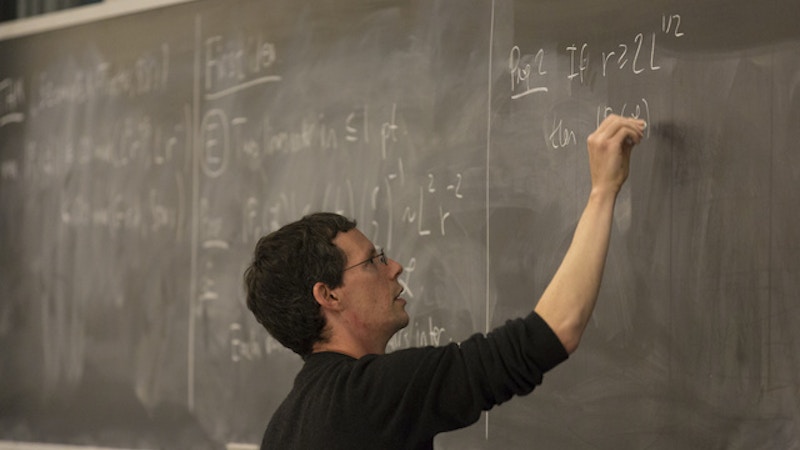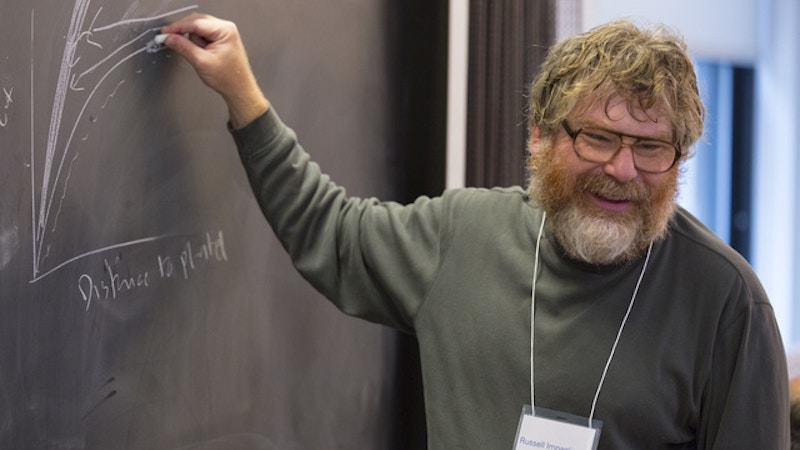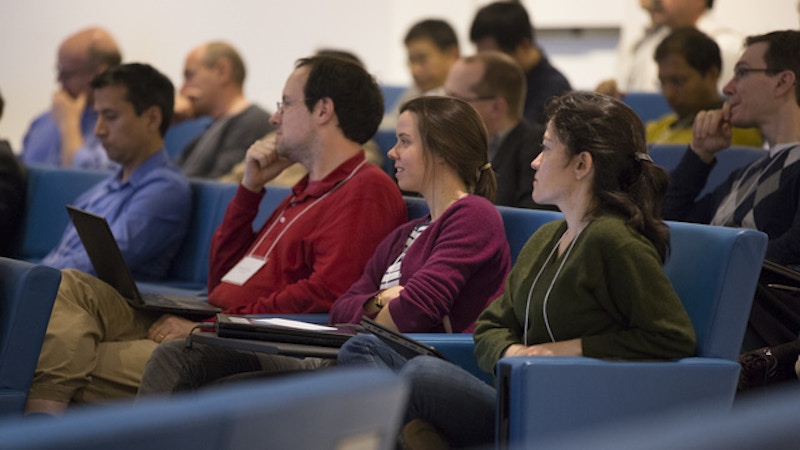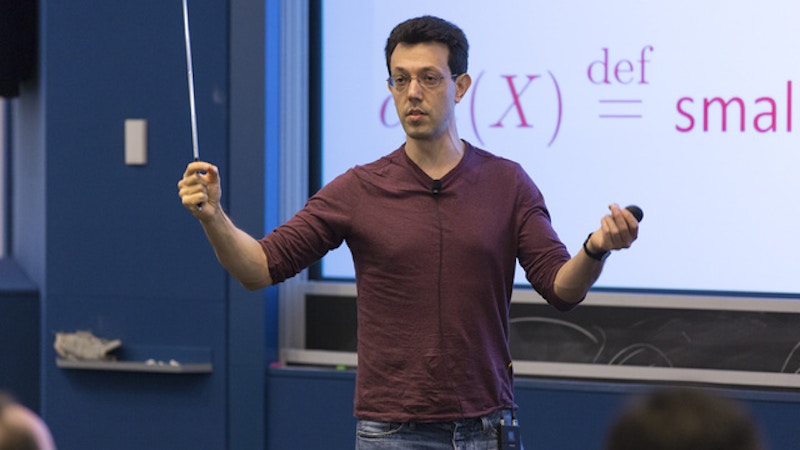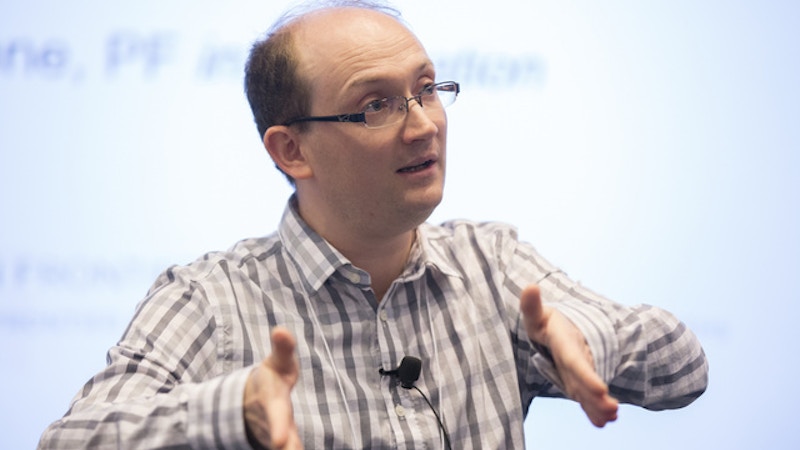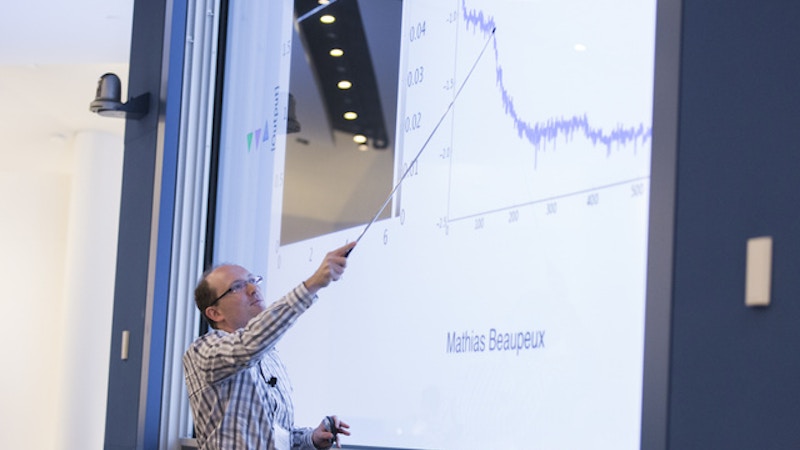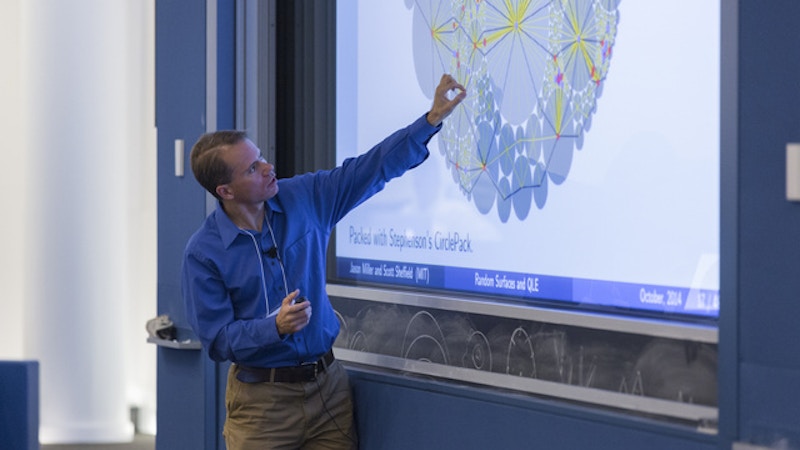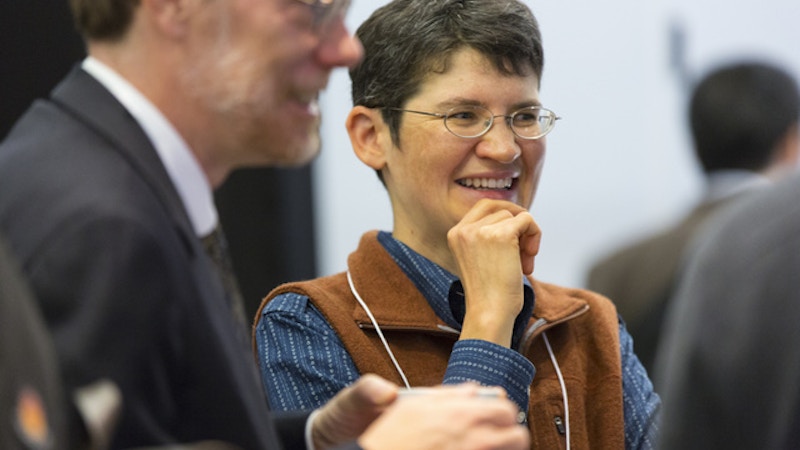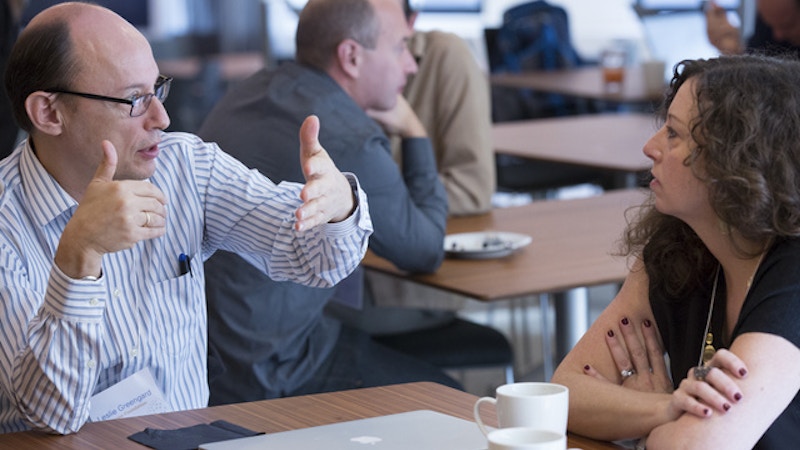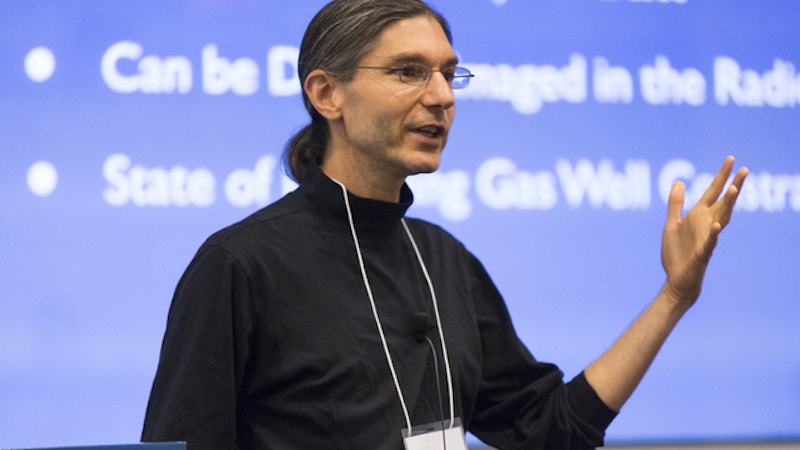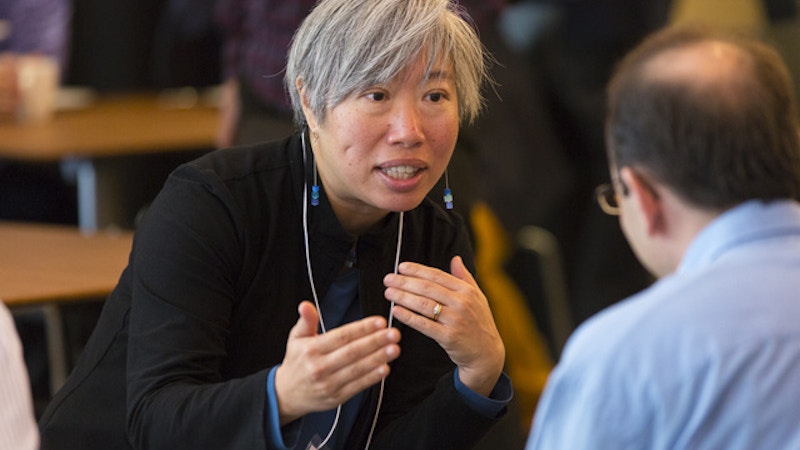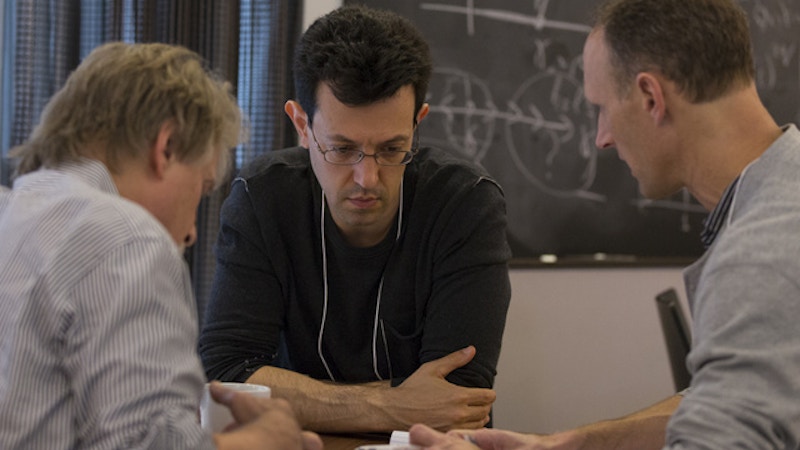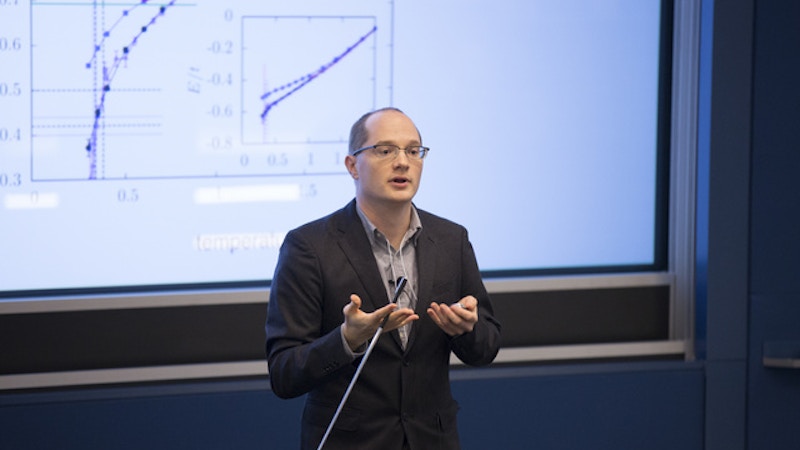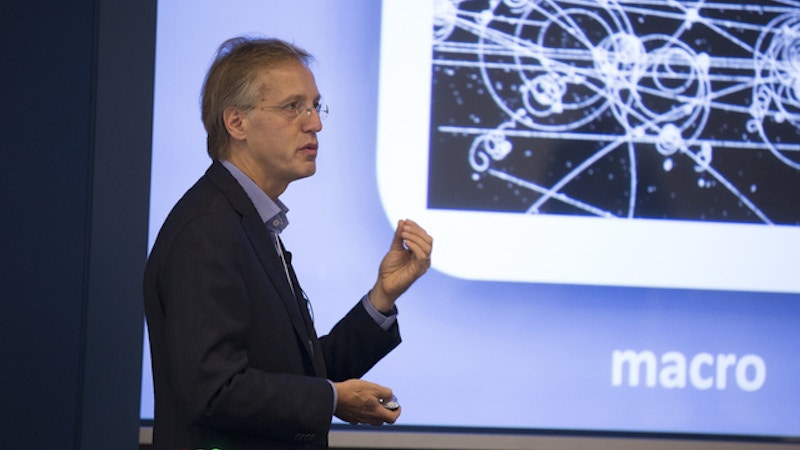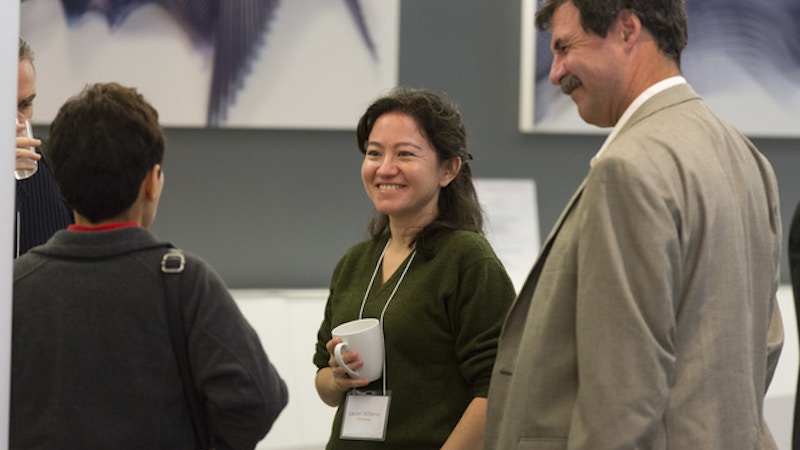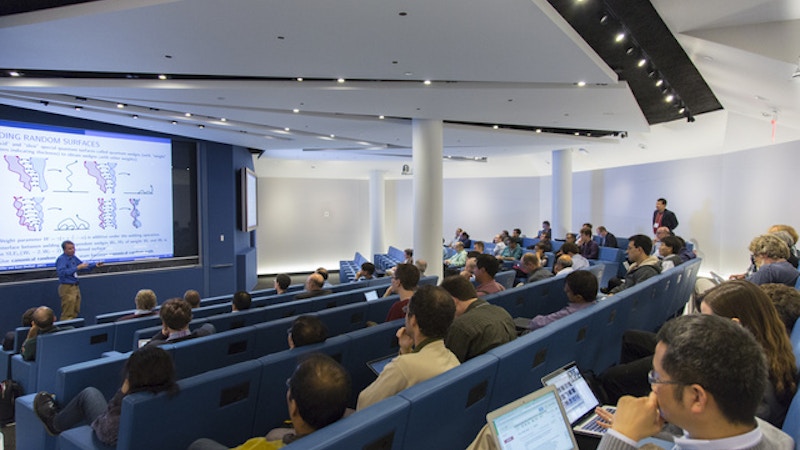2014 MPS Annual Meeting
Thursday, October 23rd – Friday, October 24th, 2014
Download the 2014 Annual Meeting booklet (PDF).
The Simons Foundation Division of Mathematics and Physical Sciences (MPS) held its second Annual Meeting on October 23 and 24, 2014. MPS-supported scientists were invited to the foundation to meet, share ideas and hear talks representing the spectrum of MPS-supported science. The topics ranged from the study of social networks to black hole astrophysics and provided a state-of-the-art overview of current science.
-
The meeting began with a keynote talk by Professor Robbert Dijkgraaf, a mathematical physicist who is the director of the Institute for Advanced Study as well as the Leon Levy Professor. Professor Dijkgraaf provided an overview on the connections between quantum field theories and mathematics, presenting many examples of how these theories have led to new concepts, uncovered hidden symmetries and provided insights into many long-standing mathematical questions, in particular, forming new bridges between algebra and geometry. Dijkgraaf concluded by observing that while there are many varieties of quantum field theories — topological, conformal, supersymmetric — giving rise to interesting mathematical structures, we currently lack an overarching understanding that would provide a unified mathematical foundation for modern-day physics.
The next speaker was Jon Kleinberg, a computer scientist at Cornell. Professor Kleinberg described methods for understanding social network interactions via a mathematical analysis of the underlying graph structure of the network. He discussed the notion of ‘contagion’ or how people are influenced to change an opinion or position by the opinions of their network contacts. He showed that people are more receptive to join a network if they are offered invitations from several independent sources. He also considered the possibility of creating a cascading effect that will produce a global change in the state of the network. Finally, Professor Kleinberg showed how to identify social relations by considering mathematical properties of graphs representing network connections. In particular, one can identify with reasonably good probability the spouse of a network member if the spouse is also an active member of the network. It also seems possible to predict with reasonable accuracy whether a new relationship will blossom or falter.
Emanuel Gull, a physicist from the University of Michigan and group director in the Simons Collaboration on the Many Electron Problem, discussed the current state of our understanding of the quantum mechanical problem posed by systems comprised of large numbers of interacting electrons and presented initial results emerging from the Simons Collaboration. He observed that while the equations describing the behavior of systems of interacting electrons have been known for many years, standard methods of solution become computationally intractable even for modest numbers of electrons, on the order of 40–50. Professor Gull presented an overview of new methods, focusing on the stochastic (Monte Carlo) exploration of abstract spaces defined by formal perturbation expansions and emphasizing the need for numerically controlled and reproducible (by different methods) results. Professor Gull concluded his talk by outlining recent results obtained by members of the Simons Collaboration concerning the Hubbard model, a canonical model in the field. Gull delineated regimes where the new approaches have solved the problem and regimes where new ideas are needed, and sketched what some of these ideas might be.
Larry Guth, a mathematician from the Massachusetts Institute of Technology, gave an overview of the field of incidence geometry. Problems in this field concern extremal relations between points, lines and circles and are therefore very easy to state. As an example, given a configuration of N lines in the plane, we can ask how many of their intersection points can lie simultaneously on R different lines. We can also ask about the structure of line configurations that give rise to many excess intersection points. Problems of this nature can be understood by high school students but are notoriously difficult to solve. Professor Guth explained how ideas from topology helped solve some basic problems in the field during the 1980s. He then presented a much more recent result, examining a more subtle problem of a similar nature which was solved using ideas from algebraic geometry. Such ideas have been used in the last decade to solve several fundamental problems that have resisted a solution for more than 50 years. He expressed hope that the incorporation of number theoretic techniques may provide further insight into the structure of extremal configurations.
Andrea Liu, from the University of Pennsylvania, concluded the first day of talks. She presented theoretical and numerical results giving new insights into the properties of ‘glasses’: materials that are solid (have rigidity against shear) but whose atoms are apparently arranged randomly, rather than in the periodically repeating patterns characteristic of crystals. She considered very simple classical mechanics models of spheres interacting with one another via short-range forces at zero temperature, showing that as the density of the objects increased, a ‘jamming’ transition occurred between a low-density liquid-like state that would flow in response to a weak force and a ‘jammed’ state, in which the positions of the particles are fixed relative to each other and which does not flow in response to a weak force. She showed that the jamming transition was continuous, characterized by mean-field critical exponents. Remarkably, the jammed state, although possessing a shear rigidity, has properties unlike other rigid solids: an infinitesimal change in pressure generates a non-infinitesimal rearrangement of the particles, and there is an extraordinarily high density of very low energy excitations. Liu argued that this feature provides a geometric explanation of a long-standing mystery, namely that in glasses — but not in ordered solids — the lattice contribution to the heat capacity is linear in temperature at low temperature. Professor Liu also drew connections between these results and random matrix theory and reported on recent analytic progress by another group, based on an infinite dimensional limit. She expressed hope that with the new understanding of these two extreme states, one might be able to obtain a much better grasp of bulk conditions leading to a better understanding of glassy states in nature.
The second day of the meeting began with a talk by Eliot Quataert, an astrophysicist from the University of California at Berkeley. The talk discussed the central role played by black holes in modern astrophysics. Inflow of matter into a black hole liberates an extraordinary amount of energy, powering many astrophysical processes and playing a crucial role in large-scale dynamics associated with the structure and formation of galaxies. Professor Quataert reviewed some of the theoretical challenges arising from attempts to simulate the dynamics of plasma that forms around black holes as intergalactic gas swirls around the hole, ultimately falling into it. A key difficulty is that while the particles in this plasma couple to each other electromagnetically, inter-particle collisions are so infrequent that the plasma cannot be modeled as a fluid, and concepts such as temperature and pressure are not relevant. Quataert concluded with a discussion of the possibilities that will be enabled when the gravitational wave observatory Advanced LIGO begins taking data, and gravitational signals of black hole mergers can be compared to information from conventional telescopes operating in the radio, infrared, visible and x-ray regimes.
Scott Sheffield a mathematician from the Massachusetts Institute of Technology, talked about models of random trees, non-intersecting curves, surfaces, growth processes and their interactions. The talk began with beautiful pictures and videos that described fractals coming from complex dynamics, known as Julia sets, and the process of gluing Julia sets together to form a sphere. After reviewing the definitions and basic properties of random trees, curves, surfaces and growth processes, Professor Sheffield explained that they can also be glued together, and that the gluing procedure exposes relations between these concepts. These gluing procedures have been studied extensively in the last five years. For example, the interface between two glued random surfaces produces a random non-intersecting curve. Random growth processes can be applied to random surfaces instead of the usual flat plane, and in some cases these processes can be well understood. Apart from producing beautiful pictures, these studies are intimately related to a better understanding of conformal field theories, considered in the first talk of the meeting, and will provide a mathematically rigorous analysis of basic physical systems.
Paul François, faculty member at McGill University and one of the inaugural group of investigators in the recently established Mathematical Modeling of Living Systems program, talked about insights into the immune system obtained from in silico (i.e., computational) experiments in which populations of theoretical models of immune systems were allowed to evolve in a computer, with random ‘mutations’ changing the structure of the equations, the survival of a given equation determined by measures of fitness derived from biological immune responses. The method produced previously unanticipated equations that accounted for key features of immune response, including the ability to sense and react to a very small density of ‘non-self’ molecules in the presence of a high density of other stimuli, and may be more generally applicable in gaining insights into complex phenomena.
Assaf Naor, a mathematician from Princeton University and the director of the Simons Collaboration on Algorithms and Geometry, gave the final talk of the MPS Annual Meeting. He discussed metric spaces, simple mathematical abstractions of the notion of distance, in which the only requirement is that the triangle inequality holds. Among metric spaces, there is a class of doubling metric spaces — a notion that attempts to capture the idea of finite dimensionality. Professor Naor discussed the basic problem of whether or not such abstract spaces can be approximated by the N-dimensional space with its usual Euclidean metric. Surprisingly, similar problems arise in the analysis of basic algorithms in graph theory. Professor Naor presented evidence that the Heisenberg group, which is central in the study of quantum mechanics, also plays a key role in understanding such questions.
Talks
Robbert Dijkgraaf
Director and Leon Levy Professor, Institute for Advanced Study
The Geometry of Quantum Field Theory
Quantum field theories are at the foundation of much of theoretical physics, yet they remain still much of a mystery, particularly at strong coupling. A recurrent theme over the past decades has been the emergence of geometries that capture the quantum properties of field theories and indicate the deep mathematical structures at play. In this lecture, Professor Dijkgraaf reviews some of the current progress in elucidating these structures.
Robbert Dijkgraaf is director and Leon Levy Professor of the Institute for Advanced Study, one of the world’s leading centers for curiosity-driven research in the sciences and humanities.
Dijkgraaf is a mathematical physicist who has made important contributions to string theory and the advancement of science education. In addition to discovering deep connections between matrix models, topological string theory and supersymmetric quantum field theory, Dijkgraaf has developed precise formulas for the counting of bound states that explain the entropy of certain black holes.
Past president of the Royal Netherlands Academy of Arts and Sciences and co-chair (since 2009) of the InterAcademy Council, Dijkgraaf is a distinguished public policy adviser and passionate advocate for science and the arts. Many of his activities — which have included frequent appearances on Dutch television, a monthly newspaper column and the launch of the science education website — are at the interface between science and society.
Jon Kleinberg
Simons Investigator in Computer Science
Cornell University
Cascading Processes and Network Structure
When individuals interact in a network, or when information is shared from person to person, the spread of the resulting behavior is often modeled as a type of cascade. At the heart of many of these models is a form of threshold-based contagion, in which an individual’s probability of changing state depends on the number of neighbors who have done so. Prof. Kleinberg analyzes a basic formulation of this threshold contagion process and show how the relative sizes of cascades can depend in subtle ways on the structure of the underlying network. Prof. Kleinberg discusses an approach to these questions that combines graph-theoretic and game-theoretic ideas, together with an application to information-sharing on Facebook.
Jon Kleinberg is noted for his creativity, intellectual ability, research scholarship, diverse research interests and the impact of his work. He is best known for his contributions in establishing the computational foundations for information retrieval and social networks. His information retrieval work includes the use of link analysis (e.g., hubs and authorities) for ranking, classifying and identifying web communities, the web as a graph and understanding the success of latent semantic analysis. His work in algorithmic social networks (a field that he can be said to have started) includes the understanding of “small worlds” and decentralized search, analysis of bursty streams and influence spread in social networks. Kleinberg has done work in many other fields, including approximation algorithms, communications networks, queuing theory, clustering, computational geometry, bioinformatics, temporal analysis of data streams, algorithmic game theory, online algorithms and distributed computing. His influence is augmented by popular papers in Science and Nature and by two widely used texts, one with Éva Tardos, Algorithm Design, and one with David Easley, Networks, Crowds and Markets: Reasoning about a Highly Connected World.
Emanuel Gull
Simons Collaboration on the Many Electron Problem
University of Michigan
Numerical Methods for the Many-Electron Problem
Professor Gull explains why the determining the quantum mechanical properties of systems of many interacting electrons is hard, in both the colloquial and the computer science sense and then shows how new ideas and algorithms are improving our understanding of this fundamental question. For the paradigm problem of the two-dimensional Hubbard model, he shows how new generations of controlled methods have solved the problem for some parameter regimes and will delineate regimes where further work is needed.
Emanuel Gull works in the general area of computational condensed matter physics with a focus on the study of correlated electronic systems in and out of equilibrium. He is an expert on Monte Carlo methods for quantum systems and one of the developers of the diagrammatic ‘continuoustime’ quantum Monte Carlo methods. His recent work includes the study of the Hubbard model using large cluster dynamical mean-field methods, the development of vertex function methods for optical (Raman and optical conductivity) probes and the development of bold-line diagrammatic algorithms for quantum impurities out of equilibrium. Professor Gull is involved in the development of open-source computer programs for strongly correlated systems.
Larry Guth
Simons Investigator in Mathematics
Massachusetts Institute of Technology
The Polynomial Method in Incidence Geometry
Incidence geometry studies the possible intersection patterns of large numbers of simple objects, such as lines or circles. For example, among all arrangements of L lines in the plane, what is the maximum possible number of r-rich points — points that lie in at least r lines? Prof. Guth discusses some classical theorems and open questions in the field. He then discusses some recent progress using simple algebraic geometry to study configurations of lines. The moral of this work is that a set of lines with a lot of combinatorial structure must also have algebraic structure — it must be well modeled by low-degree polynomials.
Larry Guth is a geometer with outstanding contributions to Riemannian geometry, symplectic geometry and combinatorial geometry. In Riemannian geometry, he solved a long-standing problem concerning sharp estimates for volumes of k-cycles. In symplectic geometry, he disproved a conjecture concerning higher-dimensional symplectic invariants by constructing ingenious counterexamples. In combinatorial geometry, he adopted a recent proof of the finite field analog of the Kakeya problem to the Euclidean context. He and Bourgain established the best current bounds to the restriction problem. Extending this work, he and Katz essentially solved one of the most well-known problems in incidence geometry, Erdös’ distinct distance problem, which was formulated in the 1940s.
Andrea Liu
Simons Fellow in Physics
University of Pennsylvania
Jamming: The Anticrystal
When we first learn the physics of solids, we are taught the theory of perfect crystals. It is only emphasized later that in the real world, all solids are imperfect. The perfect crystal is an invaluable abstraction because we can describe many real solids in terms of perturbations (i.e., defects) about this extreme limit. But such an approach fails to describe a glass, another ubiquitous form of rigid matter. Professor Liu argues that in many senses the jammed solid constitutes an extreme limit that is an opposite pole to perfect order. Like the perfect crystal, it is an abstraction that can be understood in depth and used as a starting point for understanding the mechanical properties of solids with surprisingly high amounts of order.
Andrea Liu is a theoretical physicist who studies mechanical phenomena in disordered solids and in living matter. Her research has been instrumental in the development of the field of jamming, a new way of looking at the origin and nature of rigidity in disordered solids. She discovered the jamming transition, a critical phase transition that marks the onset of rigidity in disordered packings. She has also resolved a longstanding question of how disordered solids flow by identifying ‘flow defects,’ or regions that are vulnerable to local rearrangement, analogous to dislocations in crystals.
Eliot Quataert
Simons Investigator in Physics
University of California, Berkeley
Black Hole Astrophysics
In this talk, Professor Quataert summarizes some of the key questions and outstanding problems in black hole astrophysics. Black holes play a central role in many areas of modern physics and astrophysics. Observations of plasma around the massive black hole at the center of the Milky Way provide one of the best opportunities for quantitatively testing general relativity’s strong field gravity predictions. The challenge lies in overcoming our poor understanding of the physics of dilute astrophysical plasmas. Further afield, accretion of plasma onto black holes produces the most luminous sources of radiation in the universe. The prodigious radiation and outflows produced by these accreting black holes in turn have a surprisingly large impact on the formation of galaxies and large-scale structure. The formation of black holes by the collisions of two neutron stars may power enigmatic gamma-ray bursts and produce neutron-rich heavy elements we take for granted, such as gold and platinum.
Eliot Quataert is a theoretical astrophysicist whose research combines many areas of physics, including gas dynamics, plasma physics, radiative transfer and nuclear physics. He is also known as a particularly effective mentor of students and postdocs. He has made fundamental contributions to the theory of astrophysical turbulence and transport properties in hot plasmas, as well as to stellar and black-hole astrophysics.
Scott Sheffield
Simons Fellow in Mathematics
Massachusetts Institute of Technology
Chinese Dragons and Mating Trees
What is the right way to think of a ‘random surface’ or a ‘random planar graph’? How can one explain the dendritic patterns that appear in snowflakes, coral reefs, lightning bolts and other physical systems, as well as in toy mathematical models inspired by these systems? How are these questions related to random walks and random fractal curves, such as the famous Schramm–Loewner evolution (SLE) curves? How are they related to conformal matings of Julia sets? To string theory? To statistical mechanics?
To begin to address these questions, Prof. Sheffield introduces and explains the ‘quantum Loewner evolution’ (QLE), which is a family of growth processes closely related to SLE. This work is performed in collaboration with Jason Miller.
Scott Sheffield examines conformal invariant objects which arise in the study of two-dimensional statistical physics models. He studies the Schramm–Loewner evolution SLE(K) and its relations to a variety of other random objects. For example, he proved that SLE describes the interface between two Liouville quantum gravity surfaces that have been conformally welded together. In joint work with Oded Schramm, he showed that contour lines of the Gaussian free field are related to SLE(4). With Jason Miller, he developed the theory of Gaussian free field flow lines, which include SLE(K) for all values of K, as well as many variants of SLE.
Sheffield and Bertrand Duplantier proved the Knizhnik-Polyakov-Zamolodchikov (KPZ) relation for fractal scaling dimensions in Liouville quantum gravity. Sheffield also defined the conformal loop ensembles, which serve as scaling limits of the collection of all interfaces in various statistical physics models. In joint work with Wendelin Werner, he described the conformal loop ensembles as the outer boundaries of clusters of Brownian loops.
In addition to these contributions, Sheffield has also proved results regarding internal diffusion limited aggregation, dimers, game theory, partial differential equations and Lipschitz extension theory.
Paul François
Simons Investigator in the Mathematical Modeling of Living Systems
McGill University
In Silico Evolution and Application to Immune Recognition
Despite recent advances in systems biology, it is unclear how specific dynamical properties (the phenotype) emerge from the complexity of biochemical interactions. Professor François describes an inverse-problem approach using computational evolution to reconstruct simplified networks performing a predefined biological function. He illustrates the predictive aspect of this approach on the problem of immune detection, which led to the discovery of a general mechanism of ‘adaptive sorting.’ An instance of this module is present in mammalian T-cell biochemical networks. Analytical study of this motif unifies several puzzling properties of immune recognition, such as ligand antagonism and non-monotonic response time of immune response as a function of ligand concentration.
Paul François is known for his work on physical aspects of embryonic development, in particular his analysis of the mechanisms underlying embryonic patterning, for example, the role of genetic oscillators in the development of vertebrae.
Assaf Naor
Simons Collaboration on Algorithms and Geometry
Princeton University
Doubling Metric Spaces and Embeddings
Metric spaces are abstract geometries that are ubiquitous in mathematics and the sciences in general. It is natural to try to understand such abstract structures by realizing them as subsets of well-understood geometries, such as (possibly highdimensional) Euclidean spaces. Such realizations should faithfully represent pairwise distances if they are to be useful. A metric space X admits a bi-Lipschitz embedding into a metric space Y if there exists D>0 such that one can assign to each point in X a point in Y so that for every two points in X, the distance in Y between the points that were assigned to them is within a factor of D of their initial distance in X. Among the most basic and longest-standing open problems in this area is to characterize those metric spaces X that admit a bi-Lipschitz embedding into some finite dimensional Euclidean space. This talk starts by discussing this question as well as a classical theorem of Assouad that “nearly misses” its complete resolution. This theorem focuses our attention on the doubling condition for metric spaces, which requires that every ball is contained in the union of boundedly many balls of half its radius (with the bound independent of the center or the radius of the ball in question). Understanding why Assouad’s theorem cannot fully resolve the above question leads to intriguing developments in metric geometry, with impact on theoretical computer science through links to dimensionality reduction and approximation algorithms for graph partitioning. In this talk, Prof. Naor explains these developments and present important questions that remain open.
Assaf Naor’s research focuses on analysis and geometry, as well as their interactions with approximation algorithms and computational complexity.
